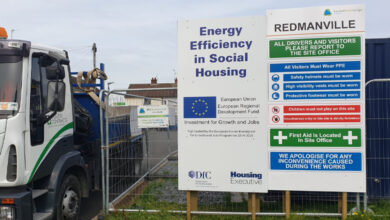Rebalancing the economy
 Peter Cheney reports on what the Treasury paper means for corporation tax and growing the private sector.
Peter Cheney reports on what the Treasury paper means for corporation tax and growing the private sector.
Getting a Secretary of State, First Minister, deputy First Minister and three other party leaders smiling in agreement together is probably a record in itself, especially six weeks before polling day. The Treasury’s corporation tax paper is also a milestone after years of Whitehall opposition.
David Varney rejected the suggestion in 2007 but Owen Paterson ran with last year’s Economic Reform Group report and lobbied the Treasury after entering government. He credits Sir George Quigley with the idea, which they first discussed at the May 2008 investment conference.
The venue was Kelvatek, a Lisburn- based engineering firm. Founded in August 2008, it currently employs 130 people. Managing Director John Cunningham aims to double the company over the coming years and hoped for a “positive response” to the consultation.
Businesses and politicians must get ready for the long haul, the paper states, as rebalancing the economy will take 25 years.
The March Budget cut the UK’s headline corporation tax rate from 27 to 26 per cent; the aim is 23 per cent by 2014. The small profits rate is 20 per cent.
If the Northern Ireland rate were 12.5 per cent, Treasury officials say that domestic investment would increase by £50-65 million and net inward investment by £105-175 million in year one.
Broader economic benefits depend on the type of investment undertaken and wider factors e.g. the level of infrastructure investment.
HMRC does not collect regional statistics on corporation tax and the Treasury therefore says it can only estimate Northern Ireland’s share of UK receipts. Two assumptions are put forward: 1.5 per cent and 1.25 per cent. Direct costs of a 12.5 per cent rate estimated in table 1.
£270 million represents 2.6 per cent of the current block grant. Two behavioural effects are also foreseen. Corporations may shift profits to Northern Ireland. ‘Tax-motivated incorporation’ (TMI) is where more local companies become corporations, to take advantage of the lower rate.
Corporation tax receipts would obviously increase in both cases, but TMI’s benefits would be offset by decreased income tax and national insurance receipts, resulting in an additional cost to the state (see table 2).
The value of corporation tax, of course, depends on company profits. UK receipts fell from £38 billion in 2006-2007 to £31 billion in 2009-2010.
Under the Azores judgment, Northern Ireland needs three types of autonomy to reduce tax:
• institutional (a separate legislature);
• procedural (no interference from Westminster in the decision); and
• fiscal (costs are not offset by aid or subsidies e.g. the block grant).
Instead of an instant reduction, the reduction could be deferred. Businesses would therefore have the confidence to invest without Northern Ireland taking an immediate financial ‘hit’.
A phased reduction would help the Executive adjust to the inevitable changes in the block grant. Estimated costs are lower (see table 3).
Northern Ireland could continue to tax non- trading profits at the UK rate. This could reduce the costs by £85 billion but some industries may benefit more than others.
Corporation tax is not the only available tool. R&D credits could be enhanced; the Government will respond to a UK-wide consultation on this subject in May. The annual investment allowance will be reduced from £100,000 to £25,000 in April 2011, but a reversal would benefit Northern Ireland’s relatively large manufacturing sector.
Training tax credits could help to improve the province’s low rate of work-based learning; these are already used in France, Belgium and Malta. The Government’s national insurance holiday, which reduces the costs of employing new staff, could be extended in Northern Ireland.
Reaction
Peter Robinson recalled how “officials ominously told me about this large beast known as the Treasury” when he was Finance Minister but was pleased to see progress. The case for a lower rate was “absolutely compelling,” according to Martin McGuinness. He later said that the banks should not benefit from the cut.
Exchequer Secretary David Gauke recognised the province’s unique circumstances: a border with the low-tax Republic, the UK’s largest public sector and the Troubles’ economic impact. He added: “It may well be the case that a lower rate of corporation tax for Northern Ireland could play a significant part in strengthening this economy.”
David Ford claimed that only a shared society could be economically prosperous. Tom Elliott noted that consultations were open for change and suggestions. Margaret Ritchie pointed out that Northern Ireland was on good terms with the EU; its approval may be needed.
“We’ve got so much going for us in Northern Ireland,” Owen Paterson said but the province needed “just something extra”. He wanted to see a lower rate than the Republic but a cut was “not in the bag”.
Welcoming the paper, CBI Director Nigel Smyth said that “lower corporation tax has significant potential to transform the Northern Ireland economy”.
Unions remain opposed. Speaking at a debate in Queen’s University on the previous night, ICTU’s northern head Peter Bunting stated: “The blanket approach of everyone getting 12.5 per cent is a tax break for people and there’s no guarantee that [multi-national] enterprises would re-invest that differential into Northern Ireland.”
The TUV and Greens claim a cut would be irresponsible and would result in more public service cuts.
Responding to trade union criticism, Gauke said those responding to the consultation should consider whether the move “increases investment, improves productivity and therefore improves wages.” He added that it was “striking” that the five main parties were backing a reduction.
A Treasury response is expected in the autumn, along with a new economic strategy from the Executive. Consultation closes on 24 June and responses can be sent to niconsultation@hm-treasury.gsi.gov.uk
Table 1
|
Direct costs (£ million) for 12.5% |
|||||
|
Share of UK base |
Year 1 |
Year 2 |
Year 3 |
Year 4 |
Year 5 |
|
1.5% |
-110 |
-235 |
-265 |
-265 |
-270 |
|
1.25% |
-90 |
-200 |
-220 |
-220 |
-225 |
Table 2
|
Behavioural effects (£ million) for 12.5% |
|||||
|
Share of UK base |
Year 1 |
Year 2 |
Year 3 |
Year 4 |
Year 5 |
|
1.5% |
-30 |
-65 |
-70 |
-80 |
-85 |
|
1.25% |
-30 |
-55 |
-70 |
-75 |
-75 |
Table 3
|
Phased reduction costs (£ million) |
|||||
|
Effects |
Year 1 |
Year 2 |
Year 3 |
Year 4 |
Year 5 |
|
Direct |
-10 |
-30 |
-55 |
-85 |
-150 |
|
Behavioural |
Negligible |
-10 |
-15 |
-20 |
-40 |





